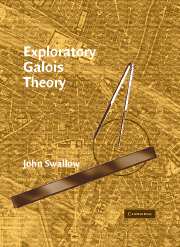Book contents
- Frontmatter
- Contents
- Preface
- Introduction
- 1 Preliminaries
- 2 Algebraic Numbers, Field Extensions, and Minimal Polynomials
- 3 Working with Algebraic Numbers, Field Extensions, and Minimal Polynomials
- 4 Multiply Generated Fields
- 5 The Galois Correspondence
- 6 Some Classical Topics
- Historical Note
- Appendix: Subgroups of Symmetric Groups
- Bibliography
- Index
Preface
Published online by Cambridge University Press: 06 July 2010
- Frontmatter
- Contents
- Preface
- Introduction
- 1 Preliminaries
- 2 Algebraic Numbers, Field Extensions, and Minimal Polynomials
- 3 Working with Algebraic Numbers, Field Extensions, and Minimal Polynomials
- 4 Multiply Generated Fields
- 5 The Galois Correspondence
- 6 Some Classical Topics
- Historical Note
- Appendix: Subgroups of Symmetric Groups
- Bibliography
- Index
Summary
My goal in this text is to develop Galois theory in as accessible a manner as possible for an undergraduate audience.
Consequently, algebraic numbers and their minimal polynomials, objects as concrete as any in field theory, are the central concepts throughout most of the presentation. Moreover, the choices of theorems, their proofs, and (where possible) their order were determined by asking natural questions about algebraic numbers and the field extensions they generate, rather than by asking how Galois theory might be presented with utmost efficiency. Some results are deliberately proved in a less general context than is possible so that readers have ample opportunities to engage the material with exercises. In order that the development of the theory does not rely too much on the mathematical expertise of the reader, hints or proof sketches are provided for a variety of problems.
The text assumes that readers will have followed a first course in abstract algebra, having learned basic results about groups and rings from one of several standard undergraduate texts. Readers do not, however, need to know many results about fields. After some preliminaries in the first chapter, giving readers a common foundation for approaching the subject, the exposition moves slowly and directly toward the Galois theory of finite extensions of the rational numbers. The focus on the early chapters, in particular, is on building intuition about algebraic numbers and algebraic field extensions.
All of us build intuition by experimenting with concrete examples, and the text incorporates, in both examples and exercises, technological tools enabling a sustained exploration of algebraic numbers.
- Type
- Chapter
- Information
- Exploratory Galois Theory , pp. ix - xiiPublisher: Cambridge University PressPrint publication year: 2004

